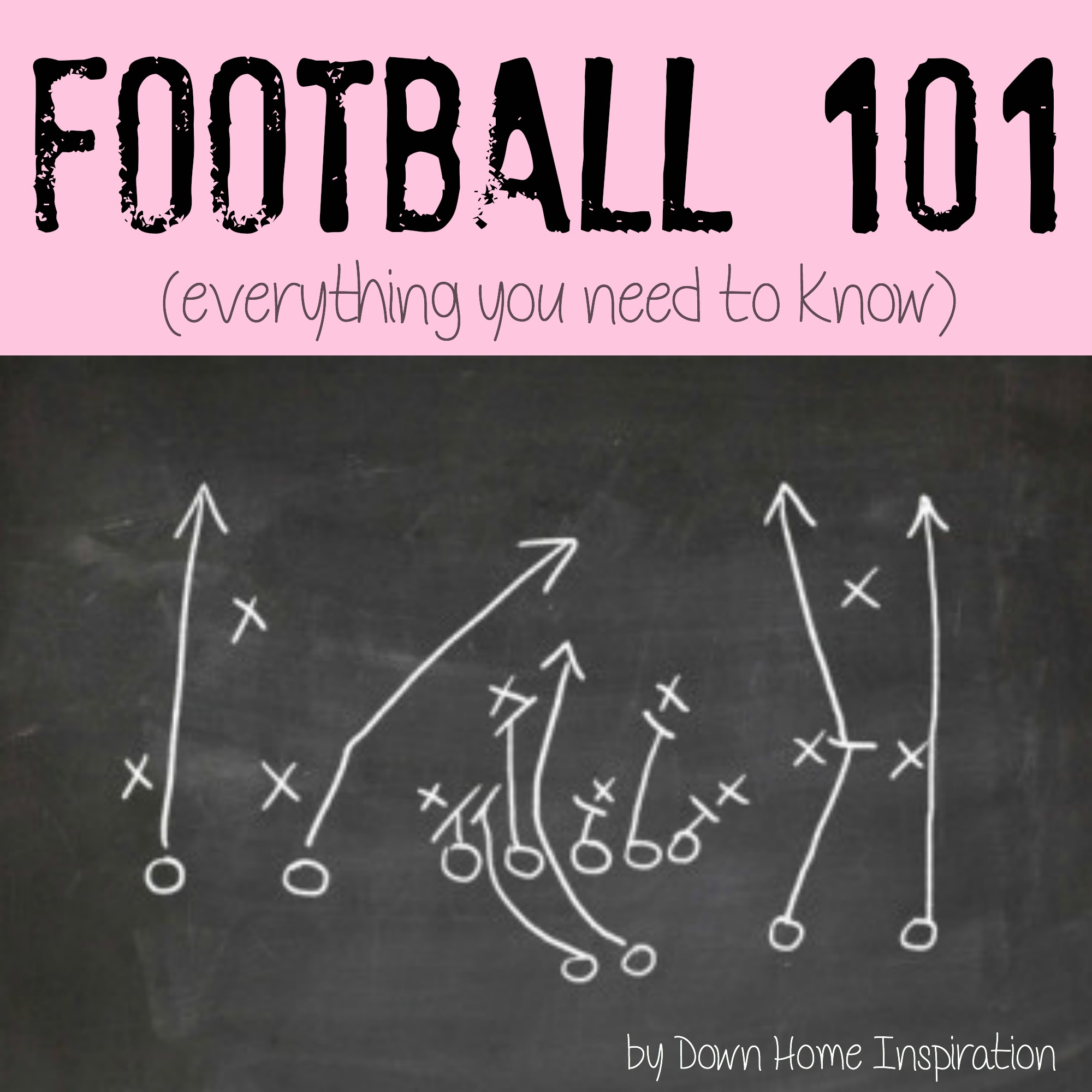I am a die hard football fan. Come September, I am basically glued to my TV anytime that there is a game on (and truthfully, then again in the mornings to hear the talking heads dissect the games). So you all know that this has been a great week for me with the season finally starting!
I LOVE it!
So much so that my family room is crimson and gold, the colors of my favorite team, the San Francisco 49ers! Yeah, that may be a bit overkill to some, but to me it’s just right.
But to make a long story short, I love to pass along my fanaticism to everyone that I can. For those who say, “I just don’t get football,” this post is for you. It is a short and simple Football 101 class that will deliver just the basics in an easy to understand way.
So go ahead and grab your remote and flip on over to NFL Network. You know you want to!
Timing
Each game is separated into four quarters that are 15 minutes each. After the first two quarters there is a 12 minute halftime, giving the players a chance to take a quick break and head to their own locker rooms for a pep talk. At the end of each quarter, the teams change the end of the field on which they are playing. There is also a 2 minute warning at the end of the first and fourth quarters. If you are watching the game on TV, all this means is it is time for a commercial break!
Following the first and third quarters, the team that is in possession of the ball (the offense is on the field) will continue on with that possession into the next quarter. However, regardless of which team had possession of the ball at the end of the second quarter, after halftime the second half will always start with a kickoff, just like the beginning of the game.
The official clock can stop for several reasons. Each time that there is an incomplete pass play (meaning that the quarterback threw the ball but no one was able to catch it), any time that a player goes out of bounds or when there is a penalty. The officials will re-spot the ball (set it where they last saw it) and then the clock can resume.
At the beginning of each play, the offense is given 40 seconds from the end of a play until they need to have the ball in motion again. If they have not snapped the ball before that 40 seconds is up they will be penalized with a delay of game. This will result in a five yard penalty.
Players and Units
Each team is allowed to have 11 players on the field at any one time. There are three units that make up each team, being the offense, defense and special teams. The offense is the unit that is in possession of the ball and they will try to get the ball down to the opposite end of the field to score. The defense is going to be lined up to stop the opposing team when they have possession of the ball. These tend to be the, ahem, stockier gentleman. They are trying to stop the opposing team from scoring and to get the ball back to their own offense as quickly as possible. Special teams units only come onto the field in kicking situations, such as punts, kickoffs and field goals.
And the Game Begins
Each and every game begins with a kickoff in which the ball is set onto a tee and a placekicker kicks the ball to the opposing special teams unit. The receiving team will try to catch the ball and run it back as far as they can before they are stopped by the kicking team. This is where the ball will be placed for the receiving team’s offense to start their drive.
If a kickoff is caught in the opposing end zone, the player can choose to either run or kneel to signal a touchback. This ends the play and the ball is then placed on the 20 yard line to start the drive. There will also be a touchback if the kicker boots the ball out of the back of the end zone which prevents the kick returner from having a chance at returning the ball. This is the goal of the kicking team because it means the opposing offense has to march the ball 80 yards to get a touchdown.
How the Ball Moves
At the line of scrimmage (where the ball has been placed and everyone lines up prior to the snap), the quarterback will call an “cadence,” which tells the center (the payer who is directly in front of him) when to snap the ball to the quarterback for the start of the play. Depending on the play that was called in the huddle, the quarterback will either run, pass or hand the ball off.
When choosing a running play, the quarterback generally hands the ball to a running back who will run for as many yards as he can before being tackled. Quarterbacks are also allowed to run with the ball, but this is not as common.
Passing is exactly as it sounds. The quarterback throws, or passes, the ball to any offense player, as long as it is thrown from behind the line of scrimmage. The ball is almost always thrown to a wide receiver, tight end, or running back. If the pass is caught it is a complete play, if the ball hits the ground, it is an incomplete play and if it is caught by the defense it is an interception and a change of possession takes place.
First Down
The white lines that are painted on the field are yard lines. All progress is measured by yards. The yellow lines that are super imposed onto the field show the yardage needed to gain a first down. The offense needs to gain yardage to work their way down the field to the end zone. Each time that the offense has the ball they have four downs (or four tries) to gain ten yards and get to that yellow line (note that the yellow line is only on TV ant not 100% accurate). If they reach the yellow line they get a first down and have earned themselves another four downs. However, if they fail to get a first down the other team gets the ball where it lays. This is why most teams will choose to kick, or punt, the ball away on fourth down so that it is further for the opposing offense.
The defense will try to keep the offense from gaining yardage to keep them from scoring, but also to keep them from getting first downs as they then have more time with the ball and higher chances of scoring. Their goal is to tackle a player to the ground to keep him from progressing. In order to be considered “down”, any part of a players body from the elbows to the knees needs to be touching the ground while a member of the defense is touching that player. A referee may also whistle a play dead if he perceives that a player has been stopped and there will be no more progress from that individual…this, while controversial, is one of many rules designed towards player safety and is dubbed “Forward Progress”.
Turnovers; Fumbles and Interceptions
A turnover occurs when the offense unintentionally gives the ball to the defense. This can happen in one of two ways; either a fumble or an interception.
A fumble happens when the ball carrier drops the ball prior to being down. Any player on the field can recover the ball and either lay on it or pick it up and run with it. Whichever team recovers the ball now has possession.
An interception, as mentioned, is what happens when the defense gets possession of the ball by catching a pass intended for the offense. They can then attempt to run it in for a touchdown. If successful, this is the phrase “pick-6” because an interception is also known as “picking” a pass.
Scoring
The winner of the game is the team who has scored the most points when the clock runs out. There are four ways to score points.
Touchdown = 6 points
Touchdowns are the biggest source of points in games. Although it is worth six points, it allows the team to try for an extra point or even a two point conversion. In order to score a touchdown, the ball needs to find its way to the end zone by being carried across the goal line or caught in the end zone. Keep in mind that defenses and special teams can also score touchdowns but it is less likely and almost always indicates a botched play by the opposing team.
Extra Point or the Two Point Conversion = 1 or 2 points
Directly after a touchdown the ball is placed on the opponents two yard line and the offense has two options on scoring. They can choose to either kick an extra point (the most common choice) that is called the point after touchdown conversion or PAT which, if successful, is worth one additional point. Or they have the option of scoring an additional two points by running or throwing the ball into the end zone, in the same manner they would score a touchdown. As you can imagine, the two point conversion is much more challenging, therefore the safer option is usually the PAT.
Field Goal = 3points
If the offense makes its way down the field but is not close enough or unable to score a touchdown, they can attempt a field goal. They can be attempted from any position on the field, and even any down, but they are generally kicked from inside the defense’s 45 yard line on fourth downs. This is because from the 45 yard line the kick is actually a little over 60 yards due to the depth of the end zone and the distance from the line of scrimmage to the place holder. The defense is allowed to try to block the ball, but all it takes in order to be “good” is for the kicker to kick the ball through and over the crossbars of the goal post. If the kick is missed, the opposing team is awarding possession of the ball from the place of the kick regardless of the down. For example, if a team tries to kick the ball on second down from the 35 yard line and misses, the opposing teams offense gets the ball at about the 40 yard line (place of the kick) even though the kicking team did not use all 4 downs.
Safety = 2 points
Safeties are relatively rare and occur only when an offensive ball carrier is tackled behind his own goal line.
I could write a book on penalties, but just know that the referee will come on with his microphone and let you know what just happened and what the actual penalty will be.
And there you have it, the ins and outs of the game. This is just the basics and there is so much more to learn and enjoy, but hopefully this will help you get your foot in the door to understanding the game of football. And remember, even if you decide that learning the rules and plays is not for you, who can turn down get togethers with delicious food and tight ends on the TV?
In case you are looking for some recipes for a game day get together, make sure to check out my:












Really great post! I’m learning slowly but surely!
Melissa@TheHappierHomemaker recently posted…20 Things to Do With Lemons
Thanks Melissa! I love the game so much that I just want to help others love it as well!